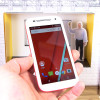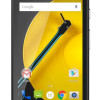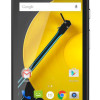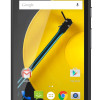Review: Motorola Moto E for Cricket Wireless
Screen
Compared to last year's model, Motorola improved the size of the E's screen from 4.3 inches to 4.5 inches, but kept the qHD resolution (960 x 540 pixels). I would not call it the sharpest display available, not by a longshot. In fact, if the Moto E has an achilles heel, the screen is probably it. My eyes, which are used to high-density displays, can see plenty of haze thanks to the lower pixel count. Brightness is OK. It looks decent when viewed directly, but falls off dramatically when viewed from an angle. The display is practically unusable outdoors. It suffices, but just barely.
Signal
One of the major improvements in the second-generation Moto E is the addition of support for LTE 4G. We tested the E on AT&T's network in and around New York City and came away impressed. (The E will initially be sold by AT&T's Cricket prepaid brand, so our tests on AT&T's network are relevant to how it will perform under the auspices of Cricket Wireless.) The Moto E always maintained a strong connection to AT&T, even in areas with known poor coverage. I did not have trouble making or receiving calls, nor did the phone drop any while I reviewed it. Data speeds over LTE were solid, but not the fastest I've seen. I didn't see much difference between surfing via HSPA or LTE, to be honest, but the E is plenty quick enough for checking your email, browsing the web, and updating your social networks.
Sound
I'd rate the Moto E as an average device when it comes to making phone calls. The earpiece speaker produces just enough volume for it to be heard in "normal" environments, such as your house, office, or car. If you're in a noisy space — such as a coffee shop during morning rush or a diner during lunch — calls are going to be hard to hear, even when the volume is turned all the way up.
Quality of calls was middling. I heard some interference and the tone was somewhat robotic to my ears. People I spoke to through the E said I sounded quiet and far away.
The speakerphone offers no improvement in either volume or quality. It's unusable in a car and is best suited to spaces that are quiet. The ringers were just barely loud enough to get my attention from several rooms away, and the vibrate alert could be much stronger.
Battery
Motorola increased the battery capacity of the second-generation Moto E from 1,980 mAh to 2,390 mAh. The result is a dramatic improvement in battery life. The Moto E always delivered a full day of mixed use. Heavy use drained the battery faster, but it still managed to reach bedtime on a single charge, even if it sputtered to that point with a few percent remaining. Using the E on 4G LTE networks didn't have any noticeable impact on battery life compared to using it only in 3G mode.
The Moto E includes the native Android 5.0 battery saver tool, which allows you to turn off radios and other functions when the battery reaches a certain level. I found it helps out a little bit if you reach a critical level, like 5% or 10%, but you really shouldn't need it.


 Hands-On: Motorola Moto E, 2nd Gen.
Hands-On: Motorola Moto E, 2nd Gen.
 Cricket to Sell Motorola Moto E Beginning March 13
Cricket to Sell Motorola Moto E Beginning March 13
 Sprint to Sell Motorola Moto E Across Its Prepaid Brands
Sprint to Sell Motorola Moto E Across Its Prepaid Brands
 Motorola Updates Moto E with LTE
Motorola Updates Moto E with LTE
 Motorola Moto E (2nd gen., LTE/GSM)
Motorola Moto E (2nd gen., LTE/GSM)





